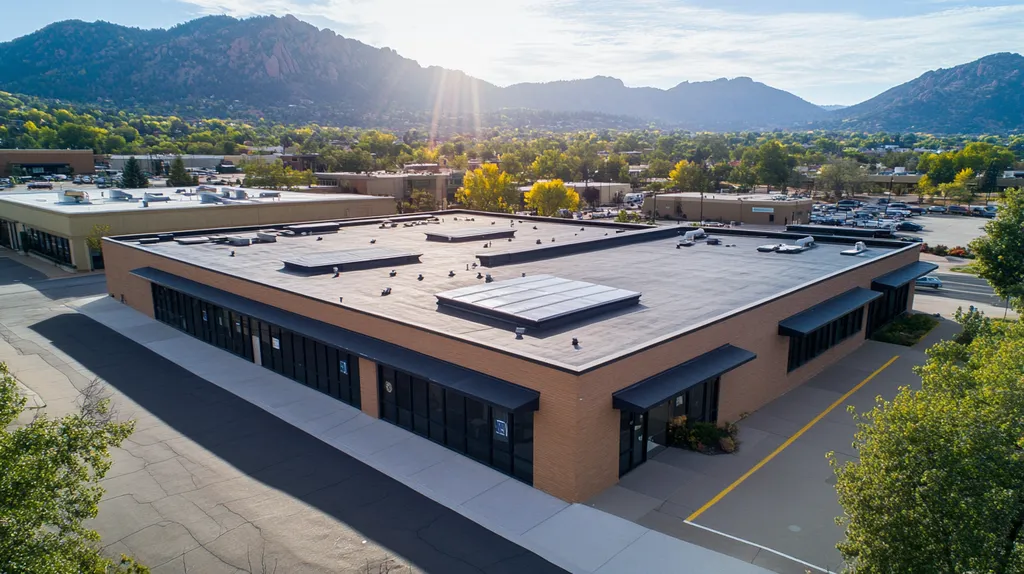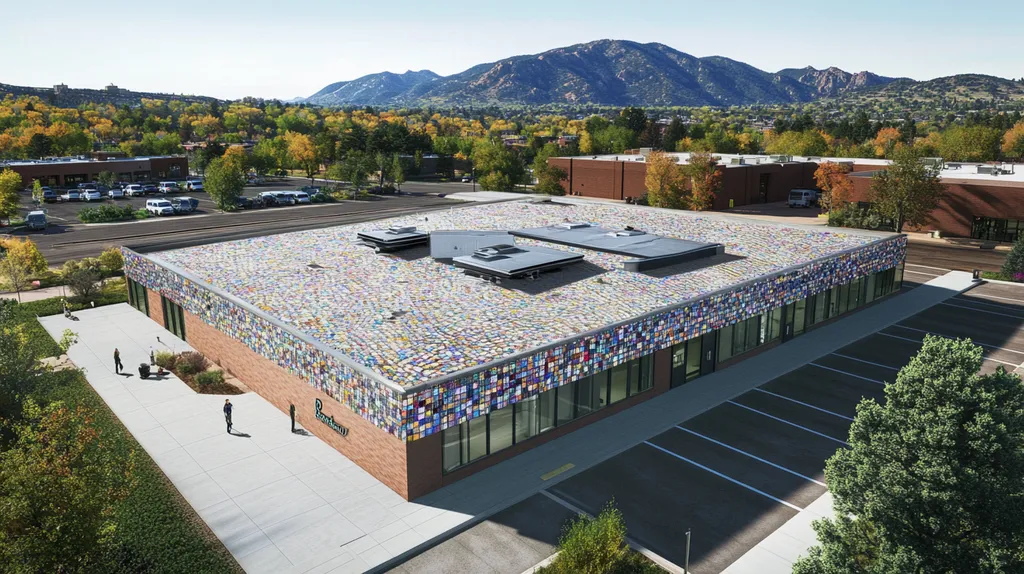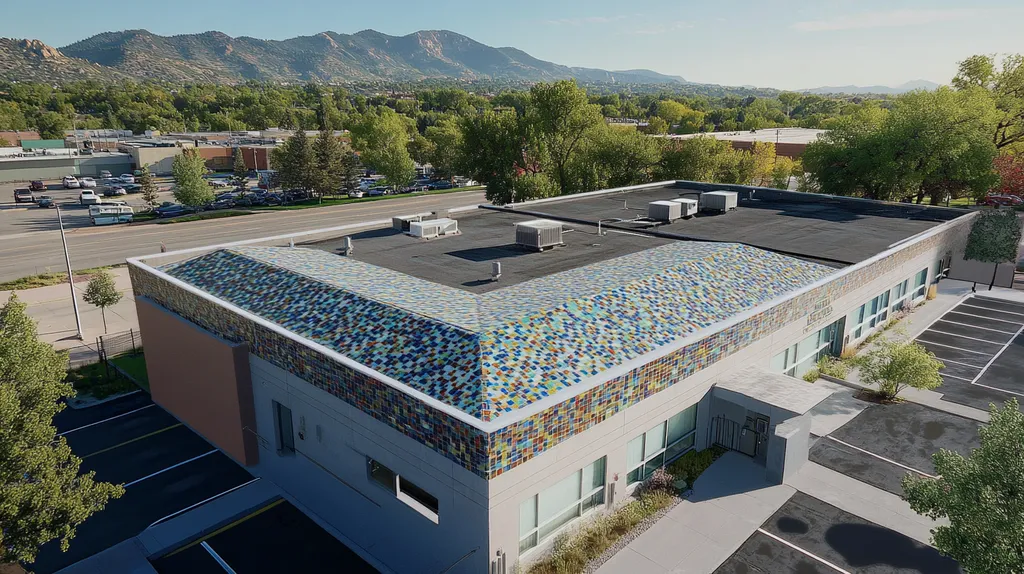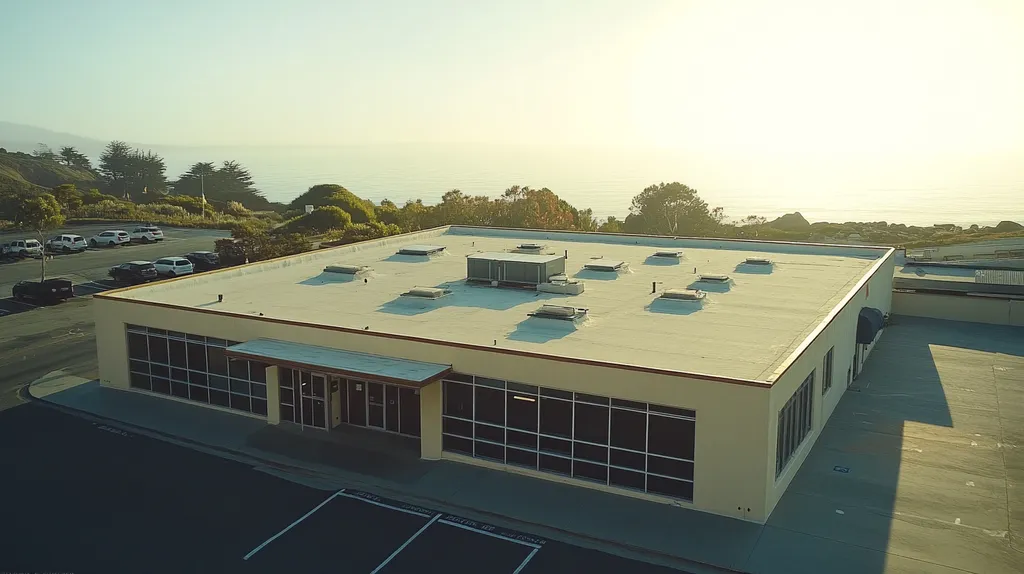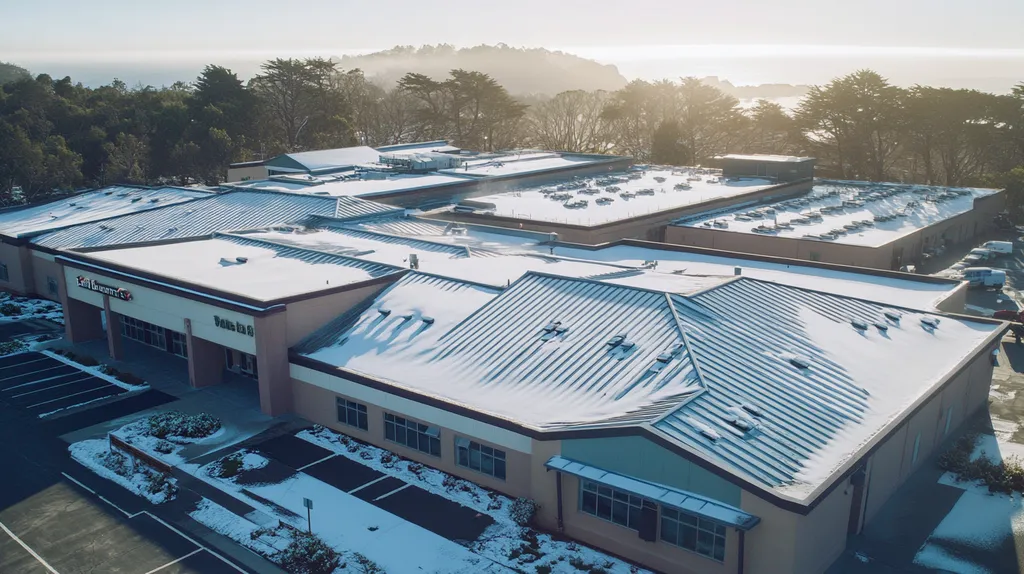In 2023, commercial property insurers reported a staggering 43% increase in extreme weather-related roof damage claims, marking an unprecedented surge in catastrophic failures across industrial and retail facilities.
As climate patterns intensify, the traditional approaches to commercial roofing have become dangerously inadequate. Modern facility managers must now contend with hurricane-force winds, record-breaking snowfall, and devastating hail events that were once considered rare occurrences.
This comprehensive guide examines the critical factors in fortifying commercial roofs against extreme conditions, from material selection and structural reinforcement to compliance requirements and long-term maintenance strategies.
SECTION 1: PERFORMANCE FACTORS
With the increasing frequency and intensity of extreme weather events, the importance of assessing commercial roofing systems has never been greater. According to the National Oceanic and Atmospheric Administration (NOAA), the economic toll of severe weather can reach billions each year. It is crucial for property owners to prioritize the durability of roofing materials, the integrity of roof systems, and effective moisture management strategies to protect their investments. This section delves into these vital performance factors.
Evaluating Roofing Material Durability under Extreme Conditions
When it comes to weather resilience, roofing materials vary significantly. Materials like TPO and PVC have been specifically designed to endure harsh winds and intense UV exposure, while traditional asphalt shingles may fall short. Selecting the right material is essential; it can be the deciding factor in whether a roof experiences minor wear or faces total failure.
Facility managers need to consider thermal resistance, flexibility, and weight, as these factors influence a roof’s capacity to withstand heavy snow or extreme temperatures. For example, materials with superior thermal resistance can handle temperature swings more efficiently, ultimately prolonging their service life and performance.
Regular inspections of roofing materials are imperative. Identifying small issues, such as cracks or peeling, before they escalate can prevent significant damage. This proactive approach not only extends a roof’s effectiveness but can lead to substantial energy cost savings as well. A well-insulated roof contributes to better energy efficiency, which is a major consideration for facility managers balancing budgets.
Key Action Items
Assessing Roof System Integrity and Load Resistance
The structural integrity of a roof system is paramount to withstanding extreme weather conditions. Each roof typically consists of multiple layers—insulation, membranes, coatings—and weaknesses in any layer can lead to disastrous outcomes during storms. A compromised layer might escalate problems during high winds or heavy rains.
Regular assessments of a roof’s load capacity are essential. This includes ensuring the roof can bear the weight of snow and other stressors. For instance, commercial roofs should be engineered to support substantial weight without bending, and neglecting to evaluate this can result in a catastrophic roof failure.
Facility managers should enlist experienced professionals for comprehensive inspections that look beyond visible damage, evaluating critical structures like decking and support trusses as well. Instituting a routine inspection schedule can significantly reduce risks. By maintaining close watch on roof conditions, property owners can safeguard against sudden failures.
Key Action Items
Ensuring Effective Drainage and Moisture Management
Proper drainage is a critical element for effective roof performance, especially in climates with heavy precipitation. Standing water can lead to dangerous leaks, mold growth, and severe structural damage. Facility managers must ensure that drainage systems operate efficiently and that roofs are designed with an appropriate slope.
Consistent maintenance of gutters, downspouts, and drainage channels can vastly improve moisture management. Blocked drainage systems can cause water to pool, escalating wear on roofing materials and increasing repair costs.
Utilizing advanced moisture management methods, such as vapor barriers, can prevent potential issues before they become problematic. These barriers help restrict moisture infiltration into the roof structure, thereby extending overall service life.
Key Action Items
SECTION 2: FINANCIAL CONSIDERATIONS
The financial implications of roofing solutions have escalated as extreme weather patterns become more common and severe. Notably, the National Oceanic and Atmospheric Administration (NOAA) reported 22 billion-dollar disasters across the U.S. in just 2021. By prioritizing investments in weather-resistant roofing materials and robust maintenance practices, facility managers can not only protect their roofs but also their overall financial health. This section discusses how to budget wisely, the potential for long-term savings, and how insurance aspects affect roofing decisions.
Budgeting for Weather-Resistant Materials and Reinforcements
Effective budget allocation for high-quality, weather-resistant roofing materials is essential for facility managers. While standard roofing options may appear less expensive upfront, they often incur increased repair costs due to harsh weather, necessitating replacement far sooner than their more durable counterparts. For instance, a cost-effective solution might need replacing in just 10 years, but premium materials could last 20 years or more.
Investing in advanced roofing technologies—such as thermoplastic polyolefin (TPO) and cool roofing systems—can mitigate the frequency and costs associated with repairs. These materials are crafted to withstand harsh UV exposure and severe storms, allowing for significant savings in the long run.
Furthermore, integrating structural reinforcements enhances a roof’s resilience against wind and heavy snow loads. This upfront investment acts as a shield against potentially costly repairs, making thoughtful budgeting a key strategy for long-term financial viability.
Key Action Items
Calculating Long-Term Cost Savings from Preventive Maintenance
Implementing preventive maintenance is crucial for managing long-term costs associated with roofing systems. Engaging in regular inspections and timely repairs stretches the lifespan of a roof, thereby averting the hefty expenses tied to premature replacements. It’s been estimated that for every dollar spent on preventive measures, property owners can save between $4 to $7 in future repair costs.
To illustrate, a robust roof maintenance program can proactively tackle minor leaks before they escalate into comprehensive water damage or operational disruptions. This forward-thinking approach not only protects the facilities but also enhances overall operational efficiency.
Utilizing advanced inspection technologies, such as infrared scans, provides additional insight into hidden roofing issues. These modern techniques lead to early detection and targeted repairs, ultimately reducing long-term expenditures.
Key Action Items
Understanding Insurance Implications and Claims Impact
The implications of insurance on roofing choices should not be overlooked. Facilities with robust, weather-resistant systems may qualify for reduced insurance premiums, providing financial benefits over time. Insurers often reward buildings designed to withstand extreme weather events with lower rates.
Conversely, facilities that experience severe damage due to inadequate roofing can face increased insurance premiums or claim denials, significantly affecting the financial landscape. It’s imperative to maintain adequate roofing standards to mitigate these risks.
Timely damage reporting is equally vital for upholding good relationships with insurers. Roofs that are well-maintained and documented with thorough inspections can lead to smoother claims processes, ensuring quicker recovery following weather-related challenges.
By grasping these insurance-related aspects, facility managers can make informed choices that secure not just their roofs but their financial stability. A strategic roofing approach harmonizes financial considerations with operational durability.
Key Action Items
SECTION 3: COMPLIANCE REQUIREMENTS
In an era where extreme weather events are increasingly common, adherence to local building codes is no longer a mere recommendation; it’s a critical necessity. Neglecting to comply with regulations regarding wind and snow loads can lead to devastating roof failures, resulting in substantial damage and safety risks. Facility managers must prioritize these compliance requirements to protect their investments and ensure operational stability.
Meeting Local Building Codes for Wind and Snow Loads
Facility managers must prioritize the ability of their roofing systems to withstand local wind and snow loads. Every jurisdiction enforces specific codes that set the minimum requirements based on geographic risks and local weather patterns. For example, regions that frequently experience heavy snowfall may necessitate roofs with steeper pitches or heightened structural support to avoid collapse.
Failure to comply can result in roofs that sustain significant damage or even catastrophic failure during extreme weather events. Local authorities regularly conduct inspections to ensure adherence to these codes, making it imperative for facility managers to be proactive about compliance for the integrity of their buildings.
Utilizing reinforced materials and conducting routine assessments can fulfill these compliance mandates. Collaborating with local experts familiar with building codes can provide insights that enhance safety and ensure legal adherence, thus safeguarding building occupants and assets.
Key Action Items
Adhering to Energy Efficiency and Reflectivity Standards
Energy efficiency has emerged as a pivotal concern in roofing compliance, helping to curtail energy costs and reduce environmental impacts. Many regions mandate that roofing materials meet specified reflectivity and insulation values, which help maintain stable indoor temperatures and optimize HVAC efficiency.
For example, roofing systems designed for high reflectivity can significantly decrease cooling costs in warmer climates. Non-compliance may result not only in inflated utility expenses but also in potential fines from regulatory bodies, underscoring the importance of adherence from a business perspective.
Facility managers should focus on using materials that boast ENERGY STAR certification, as these products adhere to rigorous energy efficiency standards. Complying with energy efficiency directives not only benefits the environment but also elevates the building’s appeal and market value.
Key Action Items
Documenting Compliance for Insurance and Safety Audits
Keeping meticulous records of compliance with roofing standards is essential for navigating insurance and safety audits. Insurers often require documentation proving that roofs meet local building codes and efficiency standards. Without this proof, facility managers may face higher premiums or even loss of coverage.
Moreover, if a weather-related incident occurs, having documented compliance can expedite insurance claims and reduce conflicts. Safety audits necessitate evidence of compliance, highlighting the importance of thorough record-keeping.
Implementing a structured documentation process will streamline compliance tracking. Facility managers should maintain detailed logs of inspections, materials utilized, and compliance certifications. Regularly updating records ensures all information is current and accessible as needed.
Key Action Items
SECTION 4: RISK MANAGEMENT
With extreme weather events becoming ever more frequent, the risk of severe roof failures demands urgent attention from facility managers. Effective risk management is essential to prevent costly repairs and disruptions to business operations. Identifying weaknesses in roofing systems, preparing for emergencies, and implementing consistent inspection routines form the backbone of a proactive approach to safeguarding properties against severe weather threats. This section outlines key strategies to fortify roof resilience.
Identifying Vulnerable Roofing Components and Failure Modes
Identifying the vulnerable components of roofing systems is the first crucial step in risk management. Areas such as seams, flashing, and penetration points often serve as the weak links that may exacerbate problems during severe weather. For instance, poor installation or age-related wear can create pathways for leaks, leading to significant internal damage during heavy rainfall or snowfall.
A thorough assessment is necessary to spot these vulnerabilities. Managers should scrutinize roof materials and evaluate their performance against wind, rain, and temperature extremes. Key factors include the roof’s age, the condition of insulation, and any previous repairs.
Involving qualified roofing professionals for detailed analyses can unearth hidden risks. Their expertise can provide insights into potential failure modes based on specific climatic conditions, allowing proactive measures to be implemented.
Key Action Items
Developing Emergency Response and Damage Mitigation Plans
Creating a robust emergency response plan is vital for mitigating damage during severe weather events. This plan should specify clear steps for personnel to follow when facing roofing emergencies. Employees need to know how to quickly recognize leaks and whom to contact for immediate help.
Regular training exercises can ensure that team members are adept at following emergency protocols. Simulated storm scenarios can allow staff to practice their responses, preparing them for real weather situations.
Forming pre-arranged contracts with experienced roofing contractors can expedite response times, allowing repair efforts to minimize damage before significant issues arise.
Key Action Items
Implementing Regular Inspection and Monitoring Protocols
Regular inspections form a cornerstone of any risk management strategy. These evaluations should occur at least twice a year and after extreme weather events. Engaging roofing professionals can help identify early signs of damage or stress, preventing minor issues from escalating into major problems.
Incorporating technology-enhanced monitoring, such as drone inspections, can streamline the process. Drones provide aerial perspectives, enabling thorough assessments of hard-to-reach areas efficiently.
Furthermore, creating a detailed checklist for inspectors ensures a comprehensive examination. Important elements to assess include loose shingles, damaged flashing, and blockages in drainage systems—all of which contribute to overall roof integrity.
Key Action Items
SECTION 5: OPERATIONAL PROCEDURES
As extreme weather events become more frequent, the importance of operational procedures for roofing systems cannot be overstated. A compromised roof may lead not only to financial burdens from repairs but also to disruptions in daily operations. The National Oceanic and Atmospheric Administration has reported an alarming trend with over 22 billion-dollar weather disasters in just one year. Adopting proactive operational strategies is crucial to ensuring roofing integrity and performance over time.
Scheduling Routine Maintenance and Seasonal Roof Checks
A systematic maintenance schedule is essential for prolonging the life of commercial roofs. Conducting inspections at least twice a year can help identify minor issues before they escalate into major problems. Even apparently harmless cracks or loose flashings can quickly signal larger leaks if left unaddressed.
Seasonal checks should prioritize removing debris from gutters and drainage systems. Buildup can obstruct the flow of water, leading to pooling on the roof and undue stress on materials. By dedicating time to these essential tasks, facility managers can maximize a roof’s lifespan and minimize unexpected repair expenses.
Documenting all inspections is equally crucial for tracking changes over time. Detailed records can highlight emerging patterns and facilitate communication with insurers and contractors. A comprehensive maintenance schedule backed with seasonal reviews helps fortify a building against unexpected issues, particularly during extreme weather conditions.
Key Action Items
Protocols for Storm Preparedness and Immediate Repairs
Preparing for storms involves a well-planned strategy that addresses all potential weak spots. This means securing loose materials and conducting a thorough assessment of the roof’s resilience against severe weather. Facility managers should create a storm readiness checklist that includes evaluating seals, checking flashing, and ensuring insulation is intact.
Implementing these protocols before storms can significantly minimize damage. Roofs that are adequately secured against wind and rain stand a much better chance of withstanding extreme conditions. Facilities conducting pre-storm inspections often find they incur lower repair costs afterward.
Equally important is having a protocol in place for immediate post-storm repairs. Establishing reliable contact with contractors ensures prompt attention to any damage, preventing leaks and limiting structural deterioration. Quick responses not only protect the building but help maintain operational continuity, a vital aspect for any business.
Key Action Items
Coordinating with Roofing Professionals and Contractors
Strong collaboration with roofing professionals is essential for effective operational management. Facility managers should build relationships with certified contractors who have expertise in commercial roofs. This collaboration helps bring industry best practices to the table, ensuring high-quality service.
Effective communication is key to aligning on maintenance schedules and repair activities. Managers should provide contractors with relevant historical data, informing decisions about necessary repairs or potential upgrades. Understanding previous material performance can lead to better strategies for reinforcing structures or deciding on replacements.
Moreover, fostering these partnerships often leads to improved pricing, expedited services, and more favorable warranty conditions. Investing in preventive maintenance contracts with trusted professionals generally results in long-term savings against reactive service approaches.
Key Action Items
SECTION 5: OPERATIONAL PROCEDURES
As extreme weather phenomena become increasingly prevalent, facility managers and property owners find themselves at significant risk. A compromised roof can lead to not only hefty repair expenses but also serious interruptions in operations. The National Oceanic and Atmospheric Administration has identified over 22 weather-related disasters costing a billion dollars each in 2021 alone. A proactive operational strategy is crucial in preserving the integrity and performance of roofing systems over time.
Scheduling Routine Maintenance and Seasonal Roof Checks
Creating a systematic maintenance schedule is essential for the longevity of commercial roofs. Regular inspections, ideally conducted twice a year, allow for the early identification of potential concerns. Minor fissures or loose flashings might seem trivial but can quickly evolve into substantial leaks without timely intervention.
Seasonal evaluations should prioritize the removal of debris from gutters and drainage systems. Accumulation can obstruct water flow, leading to unwanted pooling that causes unnecessary stress on roofing materials. By dedicating efforts to these crucial tasks, facility managers can significantly extend the lifespan of their roofs while reducing unexpected repair costs.
Documenting each inspection is equally significant. Keeping detailed records allows managers to track progression over time and highlights patterns that may signify underlying issues. Thorough documentation is also beneficial for seamless communication with insurers and contractors, ensuring informed decision-making throughout any roofing project.
Key Action Items
Protocols for Storm Preparedness and Immediate Repairs
Anticipating storms is a critical operational procedure that cannot be ignored. This process involves securing loose materials and conducting a thorough assessment of the roof’s overall resilience to inclement weather. Facility managers should create a storm readiness checklist, evaluating insulation, checking flashing, and ensuring seals are intact.
By implementing these protocols ahead of expected storms, facility managers can prevent potential damage. Properly secured roofs are far less susceptible to catastrophic failure during severe weather conditions. Facilities that conduct pre-storm inspections often find their post-storm repair expenses significantly reduced.
Additionally, it’s essential to have established protocols for immediate follow-up repairs after a storm. Having reliable contractor contacts can ensure prompt remediation of any roof damage, mitigating leaks and preventing further structural deterioration. Swift responses protect the integrity of the building while helping maintain business continuity—a crucial factor for overall success.
Key Action Items
Coordinating with Roofing Professionals and Contractors
Effective coordination with roofing professionals is vital for sound operational management. Facility managers should cultivate strong relationships with certified contractors who have specialization in commercial roofs. This collaboration brings insights grounded in industry best practices, essential for optimal roof performance.
Maintaining open lines of communication ensures that everyone is on the same page regarding maintenance schedules and repair procedures. Facility managers should share detailed historical maintenance data with contractors, as it informs decisions about repairs or possible upgrades. Understanding the past performance of materials aids critical discussions around reinforcements or replacements.
Moreover, fostering partnerships with roofing professionals often leads to better pricing, faster services, and enhanced warranty conditions. Committing to preventive maintenance contracts with trusted experts typically results in long-term savings compared to more reactive service approaches that tend to be costlier.
Key Action Items
Looking Ahead
The evidence is clear: severe weather events caused over $145 billion in commercial property damage in 2023, with failing roofs accounting for 43% of total losses.
As climate patterns intensify, traditional roofing approaches have become dangerously inadequate for protecting commercial facilities against unprecedented environmental stresses.
Success in fortifying roofs against extreme conditions requires a comprehensive strategy combining material durability, financial planning, compliance awareness, and systematic operational procedures.
The stakes could not be higher – facilities that fail to implement robust roofing protocols face not just repair costs, but business interruption, insurance complications, and potential liability issues.
The time for proactive roof management is now, before the next catastrophic weather event tests system resilience.
FREQUENTLY ASKED QUESTIONS
Q. How can I evaluate the durability of my commercial roof?
A. Assess roofing material types and their resistance. Regular inspections help identify damage early, promoting proactive maintenance.
Q. What budgeting strategies are effective for industrial roofs?
A. Prioritize high-quality materials that offer long-term savings. Evaluate expected lifespans and avoid frequent replacements to manage costs effectively.
Q. What are the compliance requirements for my commercial roof?
A. Ensure adherence to local building codes for wind and snow loads. Regular evaluations keep your property compliant and secure.
Q. How can I manage risks associated with my industrial roof?
A. Identify vulnerable areas like seams and flashing. Regular inspections and establishing emergency protocols mitigate risks effectively.
Q. What operational procedures should I implement for roofing systems?
A. Establish routine inspections and seasonal checks. Maintain clear communication with contractors for prompt repairs and assessments.
Q. What immediate actions should I take after a storm affects my roof?
A. Inspect for damage and document any issues. Contact roofing professionals promptly to address repairs and prevent further deterioration.
Q. How do roofing warranties work for commercial roofs?
A. Warranties typically cover defects in materials and workmanship. Understanding the specifics can guide maintenance and repair responsibilities effectively.

